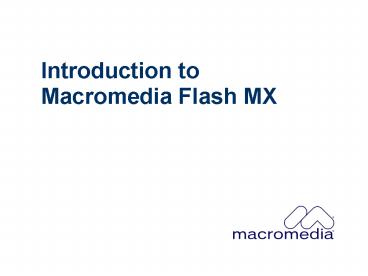Introduction to Macromedia Flash MX - PowerPoint PPT Presentation
1 / 16
Title:
Introduction to Macromedia Flash MX
Description:
animations. text. sounds. buttons. frame actions. 10 2002 Macromedia, Inc. Symbols and Libraries ... In Macromedia Flash, a shape is a vector-based object. ... – PowerPoint PPT presentation
Number of Views:162
Avg rating:3.0/5.0
Title: Introduction to Macromedia Flash MX
1
Introduction to Macromedia Flash MX
2
Macromedia Flash MX Workspace
Toolbox
Panels
Timeline
Layers
Currentscene
Stage
Work area
Property inspector
3
Stage
- Where you compose content in a movie
- Set Stage size to match a specific browser size
4
Toolbox
- Tools create the content of a movie.
- Tools Draw, paint, create text, select objects,
modify objects, and erase objects - View Zoom and pan
- Color Set stroke and fill colors
- Options Modify the currently selected tool
5
Panels
Options menu control
- Additional tools for creating and editing movies
- Click the Options menu control to view additional
options for the current panel. - You can hide or show panels using the options on
the Window menu.
6
Timeline
- Organize and control the content of a movie over
time.
Frames
Playhead
Layers
Frame rate
7
Frames and Keyframes
- Frames Like films, Macromedia Flash movies
divide lengths of time into frames, which are
organized in the Timeline. - Keyframes Frames that define a change in what is
displayed in a movie or include frame actions to
modify a movie. When you open a new blank movie
document, it contains one layer with one blank
keyframe.
8
Frames and Keyframes
Keyframe with content
Empty frames
Blank keyframe
Empty slots for new frames
9
Layers
- Layers are like multiple film strips stacked on
top of each other, each with a different element
that appears on the Stage. - graphics
- animations
- text
- sounds
- buttons
- frame actions
10
Symbols and Libraries
- Symbols are elements that you reuse within a
movie to reduce file size. - Types of symbols include graphics, buttons, movie
clips, sound files, and text. - A library is where you store and organize
symbols. - When you drag a symbol from a library to the
Stage, you create an instance of the symbol.
11
Advantages of Using Symbols
- Easy Editing If you change the symbol in the
library, all instances of the symbol are updated
automatically. - Smaller File Sizes Symbols are downloaded only
once, regardless of the number of instances
youve included in the movie. This reduces the
size of your published movies and decreases
download times.
12
Animation with Tweening
- Tweening A series of frames that change
incrementally to create smooth movement or change
over time. - You can set the beginning and ending frames, and
have Macromedia Flash automatically create the
frames in between. - Macromedia Flash has two types of tweening shape
tweening and motion tweening.
13
Shape and Motion Tweening
- In Macromedia Flash, a shape is a vector-based
object. You create a shape by using the drawing
tools or by importing a vector drawing from
another program. - Use shape tweening to animate one shape into
another. You cannot shape-tween grouped objects,
bitmaps, text that has not been broken apart, or
symbols. - Use motion tweening to animate symbols, groups,
and text blocks.
14
Shape and Motion Tweening
15
Sound
- First, import a sound file into the library.
- Add sound to a movie by dragging an instance of
the sound into a frame. - To minimize file size, loop shorter sounds (to
make them repeat).
16
Actions
- ActionScript statements instruct a movie to do
something while it is playing. - Frame action An action attached to a frame is
triggered when the movie plays that frame. - Object action An action attached to an object is
triggered when the viewer interacts with the
object, such as moving the pointer over a hotspot
or clicking a button.































